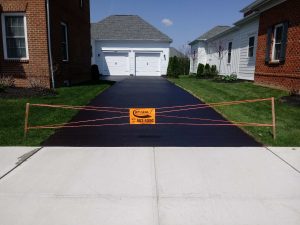Unlock the Secrets of Asphalt Sealing: Taking Full Advantage Of Hot Mix Asphalt Durability
Hot Mix Asphalt: A Lasting Option for Sidewalk
Warm Mix Asphalt (HMA) has actually arised as a leading sustainable option for sidewalk options, using a myriad of ingenious innovations and environmental benefits. Its capability to recycle materials and minimize energy consumption provides an engaging instance for its adoption in roadway construction tasks. The long-term performance and sturdiness of HMA make it a favored alternative for facilities growth. As the demand for environmentally friendly building and construction methods expands, checking out the subtleties of HMA's sustainability can provide valuable insights into the future of pavement services.
Ecological Advantages of Warm Mix Asphalt

Furthermore, Warm Mix Asphalt assists to minimize metropolitan heat island effects. Its dark shade soaks up sunshine, decreasing the quantity of warmth reflected back right into the environment contrasted to lighter-colored sidewalks. This can decrease ambient temperature levels in urban areas, decreasing the need for air conditioning and ultimately minimizing power consumption.
Additionally, Warm Mix Asphalt adds to improved stormwater monitoring. Its porous nature enables water to charge and penetrate the sidewalk groundwater materials, reducing runoff and the danger of flooding. These environmental benefits make Hot Mix Asphalt a lasting choice for paving roadways and freeways.
Power Efficiency in HMA Manufacturing
Is power performance a vital element in the manufacturing of Hot Mix Asphalt (HMA)? Power plays a significant duty in the production of HMA, impacting both price and ecological sustainability. One essential facet of energy efficiency in HMA production is the usage of warm mix asphalt (WMA) innovations.
In addition, advancements in plant technologies have led to more energy-efficient HMA manufacturing procedures. By maximizing power use in HMA manufacturing, the sector can minimize its carbon impact while preserving top notch sidewalk products.
Recyclability of Warm Mix Asphalt
The recyclability of Warm Mix Asphalt (HMA) is a critical aspect of its sustainability and long-term environmental influence. HMA is one of one of the most recycled products in the USA, with over 100 million heaps of reclaimed asphalt pavement (RAP) being recycled annually in brand-new sidewalk building and construction. Recycling HMA provides a number of environmental advantages, such as reducing the requirement for virgin products, decreasing energy intake during production, and decreasing the quantity of waste sent out to garbage dumps.
The procedure of reusing HMA entails milling the existing pavement, squashing it right into smaller pieces, and blending it with brand-new accumulation and asphalt binder to create a recycled mix. This recycled mix can usually carry out as well as or even better than conventional HMA, while calling for fewer raw products and generating lower greenhouse gas emissions. By incorporating RAP right into new pavement jobs, roadway firms can conserve natural deposits, minimize expenses, and reduce the ecological impact of roadway construction and upkeep tasks. In general, the recyclability of HMA plays a substantial function in promoting lasting methods within the pavement sector.

Long-Term Performance of HMA
Asphalt pavements demonstrate sturdiness and durability over an extensive duration, mirroring the lasting performance of Warm Mix Asphalt (HMA) The longevity of HMA can be credited to its ability to endure rush hour loads, severe weather, and the results of aging. Research studies have shown that properly designed and correctly created HMA pavements can last for twenty years or more with routine maintenance. The trick to taking full advantage of the long-term efficiency of HMA depends on making use of top notch products, complying with ideal methods in building and construction, and implementing reliable upkeep approaches. Correct drain, regular examinations, and prompt repairs are essential for maintaining the structural honesty of HMA pavements in time. Furthermore, advancements in HMA technology, such as using polymer-modified binders and warm mix asphalt, have actually additionally enhanced the sturdiness and long life of HMA pavements. By focusing on quality building and construction and upkeep methods, HMA continues to prove itself as a lasting and affordable solution for lasting pavement framework.

HMA: Sturdiness and Sustainability
Demonstrating both toughness and sustainability, Warm Mix Asphalt (HMA) has ended up being a cornerstone in the building and construction of resilient sidewalk facilities - regrading. HMA's sturdiness originates from its ability to withstand hefty loads, rough climate condition, and high traffic volumes, making it a reliable selection for highways, highways, and airport terminal paths. The make-up of HMA, which generally consists of aggregates, binder, and filler, plays an important function in enhancing its durability and resistance to tear and wear
Furthermore, HMA's sustainability hinges on Clicking Here its recyclability and energy-efficient manufacturing process. The capacity to recycle redeemed asphalt pavement (RAP) in brand-new HMA mixtures reduces the need for virgin materials and decreases the ecological impact of sidewalk construction and upkeep. Additionally, the power efficiency of creating HMA depends on its lower mixing temperatures contrasted to various other sidewalk materials, leading to decreased energy intake and greenhouse gas emissions.
Final Thought
In final thought, warm mix asphalt (HMA) uses a lasting solution for sidewalk with its environmentally pleasant characteristics. HMA's recyclability, energy efficiency in manufacturing, and long-lasting toughness make it a green option for road construction.
HMA is one of the most recycled materials in the United States, with over 100 million bunches of recovered asphalt sidewalk (RAP) being recycled yearly in brand-new pavement building and construction.The process of recycling HMA entails crushing the existing sidewalk, squashing it right into smaller sized items, and mixing it with new aggregate hot mix asphalt and asphalt binder to create a recycled mix.Asphalt sidewalks demonstrate longevity and resilience over a prolonged period, showing the long-lasting efficiency of Warm Mix Asphalt (HMA) Furthermore, developments in HMA technology, such as the usage of polymer-modified binders and cozy mix asphalt, have further improved the sturdiness and longevity of HMA additional hints sidewalks. The capacity to reuse recovered asphalt pavement (RAP) in brand-new HMA mixes minimizes the need for virgin materials and reduces the ecological effect of sidewalk building and construction and upkeep.